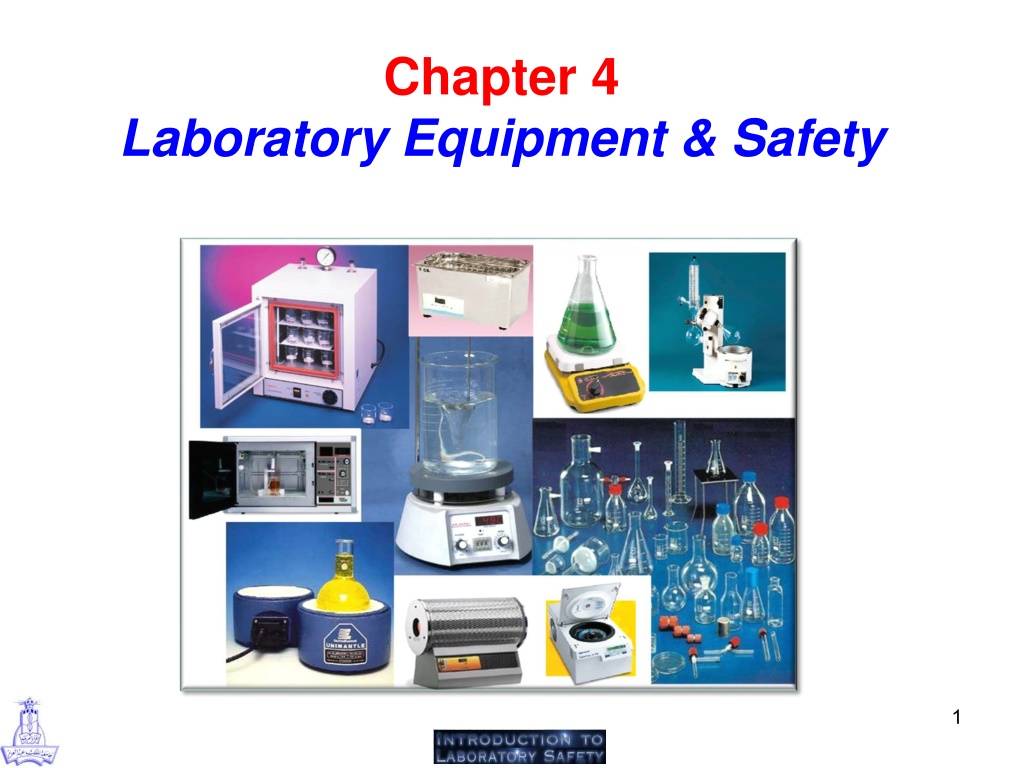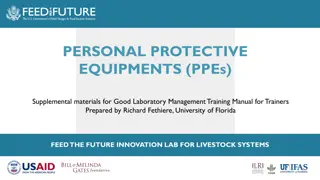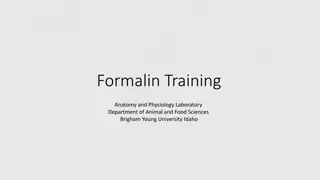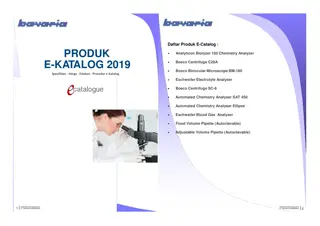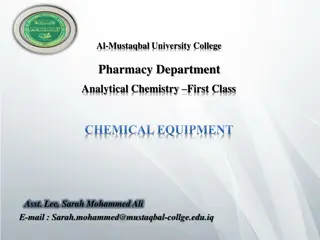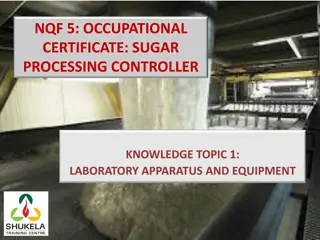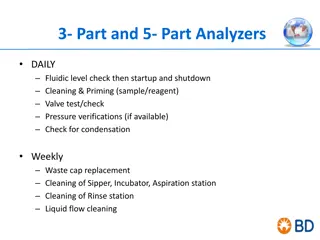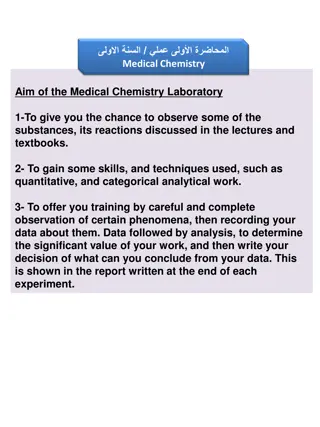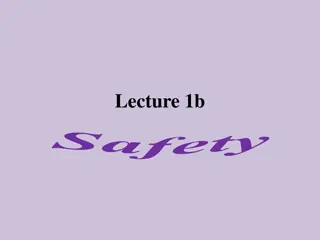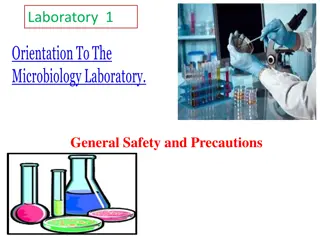Laboratory Equipment and Safety Guidelines
Chemistry laboratories require various equipment for educational and research purposes. This section discusses the types of equipment, their usage, potential hazards, and safety measures to prevent accidents. It covers topics such as refrigerators and freezers, stirring and mixing devices, heating devices like ovens and hot plates, and the precautions associated with each.
Download Presentation

Please find below an Image/Link to download the presentation.
The content on the website is provided AS IS for your information and personal use only. It may not be sold, licensed, or shared on other websites without obtaining consent from the author.If you encounter any issues during the download, it is possible that the publisher has removed the file from their server.
You are allowed to download the files provided on this website for personal or commercial use, subject to the condition that they are used lawfully. All files are the property of their respective owners.
The content on the website is provided AS IS for your information and personal use only. It may not be sold, licensed, or shared on other websites without obtaining consent from the author.
E N D
Presentation Transcript
Chapter 4 Laboratory Equipment & Safety 1
Most of the chemistry laboratory contains many types of equipment that are necessary for their educational or research work. In this section, different equipments, their usage, and potential hazards and how to avoided will be explained. 2
1) Refrigerators and Freezers Used for chemicals needs to be stored at temperatures lower than the ambient temperatures. Only refrigerators and freezers specified for laboratory use should be utilized for the storage of chemicals. Potential hazards: vapors from the contents, the possible presence of incompatible chemicals and spillage. Do not store flammable liquids in a refrigerator unless it is approved for such storage to avoid ignition from regular electrical fans and motors located inside the located inside the refrigerator. Flammable liquid-approved refrigerators are designed with spark- producing parts on the outside to avoid accidental ignition.
2) Stirring and Mixing Devices Used for stirring and mixing chemicals during reactions. Include stirring motors, magnetic stirrers, shakers, small pumps for fluids and rotary evaporators for solvent removal. Only spark-free induction motors should be used in power stirring and mixing devices or any other rotating equipment used for laboratory operations. Potential hazards: Because stirring and mixing devices, especially stirring motors and magnetic stirrers, are often operated for fairly long periods without constant attention, the consequences of stirrer failure, electrical overload or blockage of the motion of the stirring impeller should be considered.
3) Heating Devices 3.1 Ovens Used to remove water or other solvents from chemical samples and to dry laboratory glassware. Potential hazards: Ovens should not be used to dry any chemical sample that might pose a hazard because of acute or chronic toxicity unless special precautions have been taken to ensure continuous venting of the atmosphere inside the oven. Bimetallic strip thermometers are preferred for monitoring oven temperatures. Mercury thermometers should not be mounted through holes in the top of ovens so that the bulb hangs into the oven. Should a mercury thermometer be broken in an oven of any type, the oven should be closed and turned off immediately, and it should remain closed until cool.
3.2 Hot Plates Used for heating solutions to 100o C or above when inherently safer steam baths cannot be used. Potential hazards: Laboratory hot plates should avoids electrical sparks. Do not store volatile flammable materials near a hot plate Limit use of older hot plates for flammable materials. Check for corrosion of thermostats. Corroded bimetallic thermostats can be repaired or reconfigured to avoid spark hazards.
3.3 Heating Mantles Used for heating round-bottomed flasks, reaction kettles and related reaction vessels. Potential hazards: These mantles enclose a heating element in a series of layers of fiberglass cloth. As long as the fiberglass coating is not worn or broken, and as long as no water or other chemicals are spilled into the mantle, heating mantles pose no shock hazard. Be careful not to exceed the input voltage recommended by the mantle manufacturer. Higher voltages will cause it to overheat, melt the fiberglass insulation and expose the bare heating element.
3.4 Oil, Salt and Sand Baths Used to heat small or irregularly shaped vessels or when a stable heat source that can be maintained at a constant temperature is desired. General precaution: Take care with hot oil baths not to generate smoke or have the oil burst into flames from overheating. Always monitor oil baths by using a thermometer or other thermal sensing devices to ensure that its temperature does not exceed the flash point of the oil being used. Fit oil baths left unattended with thermal sensing devices that will turn off the electric power if the bath overheats. Mix oil baths well to ensure that there are no hot spots around the elements. Contain heated oil in a vessel that can withstand an accidental strike by a hard object.
3.5 Hot Air Baths and Tube Furnaces Tube furnaces are often used for high-temperature reactions under pressure. General precaution: Ensure that the heating element is completely enclosed. For air baths constructed of glass, wrap the vessel with heat resistant tape to contain the glass if it should break. Sand baths are generally preferable to air baths. For tube furnaces, carefully select glassware and metal tubes and joints to ensure they are able to withstand the pressure. Follow safe practices outlined for both electrical safety and pressure and vacuum systems.
3.6 Heat Guns Used to dry glassware or to heat the upper parts of a distillation apparatus during distillation of high-boiling materials. Potential hazards:Sparks General precaution: Any hand-held heating device of this type that will be used in a laboratory should have ground-fault circuit interrupter (GFCI) protection to ensure against electric shock. Never use a heat gun near flammable materials including open containers of flammable liquids, flammable vapors or hoods used to control flammable vapors.
3.7 Microwave Ovens Potential hazards: Sparks that can ignite flammable vapors. Metals placed inside the microwave oven may produce an arc that can ignite flammable materials. Materials placed inside the oven may overheat and ignite. Sealed containers, even if loosely sealed, can build pressure upon expansion during heating, creating a risk of container rupture.
General precaution for microwave: Never operate microwave ovens with doors open in order to avoid exposure to microwaves. Do not place wires and other objects between the sealing surface and the door on the oven s front face. The sealing surfaces must be kept absolutely clean. Never use a microwave oven for both laboratory use and food preparation. Electrically ground the microwave. - Do not use metal containers and metal-containing objects (e.g., stir bars) in the microwave. They can cause arcing. Do not heat sealed containers in the microwave oven because containers could explode. Remove screw caps from containers being microwaved. If the sterility of the contents must be preserved, use cotton or foam plugs. Otherwise plug the container with kimwipes to reduce splash potential.
3.8 Ultrsonicators Potential hazards: exposure to the associated high volumes of audible sound can produce a variety of effects, including fatigue, headaches, nausea and tinnitus. Exposure to ultrasonically vibrating solids, such as an acoustic horn, can lead to rapid frictional heating and potentially severe burns. General precaution: Ultrasonicator must be enclosed in a 2-cm thick wooden box or in a box lined with acoustically absorbing foam or tiles to substantially reduce acoustic emissions (most of which are inaudible). Direct contact of the body with liquids or solids subjected to high- intensity ultrasound of the sort used to promote chemical reactions should be avoided.
4) Centrifuges Used for the separation of different components in solution. Potential hazards: For flammable and/or hazardous materials, the centrifuge should be under negative pressure to a suitable exhaust system. General precaution: Centrifuges should be properly installed and must be operated only by trained person. It is important that the load is balanced each time the centrifuge is used and that the lid is closed while the rotor is in motion. The disconnect switch must be working properly to shut off the equipment when the top is opened. The manufacturer s instructions for safe operating speeds must be followed.
5) Rotary Evaporator Used for separation of organic components depending on their boiling points through evaporation at one side and distillation at another side. General precaution: Glass components of the rotary evaporator should be made of Pyrex or similar glass. Glass vessels should be completely enclosed in a shield to guard against flying glass should the components implode. Increase in rotation speed and application of vacuum to the flask whose solvent is to be evaporated should be gradual.
6) Autoclaves Autoclave is a very effective way to decontaminate infectious waste. Autoclaves work by killing microbes with superheated steam. General precaution: Do not put sharp or pointed contaminated objects into an autoclave bag. Use caution when handling an infectious waste autoclave bag. Never lift a bag from the bottom to load it into the chamber. Handle the bag from the top. Do not overfill an autoclave bag. Do not overload an autoclave. Conduct autoclave sterility testing on a regular basis. Do not mix contaminated and clean items together during the same autoclave cycle. Always wear personal protective equipment. Be on the alert when handling pressurized containers.
7) Electrophoresis Devices Used in molecular biology and medicine. It is applied for the separation and characterization of proteins, nucleic acids and subcellular-sized particles like viruses and small organelles. General precaution: Turn the power off before connecting the electrical leads. Connect one lead at a time, using one hand only. Ensure that hands are dry while connecting leads. Keep the apparatus away from sinks or other water sources Turn off power before opening lid or reaching inside chamber Do not override safety devices Do not run electrophoresis equipment unattended. Mix all stock solutions in a chemical fume hood. Provide spill containment by mixing gels on a plastic tray. Decontaminate surfaces with ethanol. Dispose of all cleanup materials as hazardous waste.
8) Glassware General precaution: Pressure and vacuum operations in glass vessels should be conducted behind adequate shielding. It is advisable to check for flaws such as star cracks, scratches and etching marks each time a vacuum apparatus is used. Only round-bottomed or thick-walled (e.g., Pyrex) evacuated reaction vessels specifically designed for operations at reduced pressure should be used. Repaired glassware is subject to thermal shock and should be avoided. Thin-walled, Erlenmeyer or round-bottomed flasks larger than 1 L should never be evacuated.
9) Vacuum Used in the lab to remove air and other vapors from a vessel or manifold. Potential hazards: Hazardous chemicals can escape from the vacuum pump and pump should be place in the hood. Cold traps and acid traps can be helpful, but if allowed to thaw or saturate, they can lose their effectiveness.
summary Refrigerators and Freezers Stirring and Mixing Devices Heating Devices Ovens. Hot Plates Heating Mantles Oil, Salt and Sand Baths Hot Air Baths and Tube Furnaces Heat Guns Microwave Ovens Ultrsonicators Centrifuges Rotary Evaporator Autoclaves Electrophoresis Devices Glassware Vacuum
